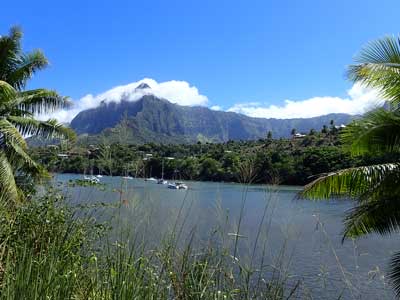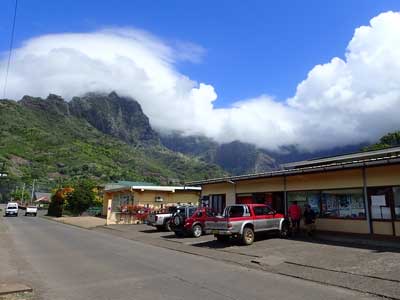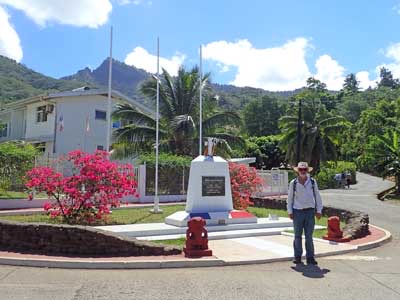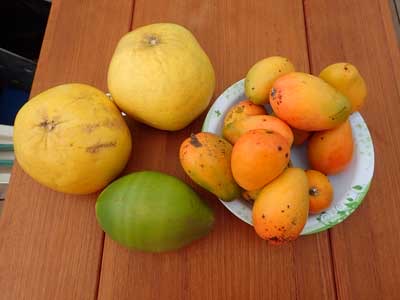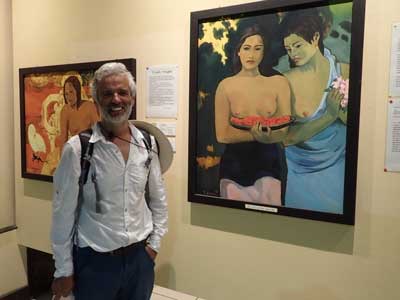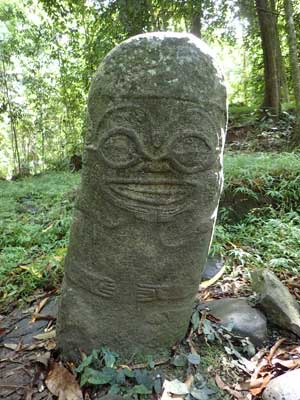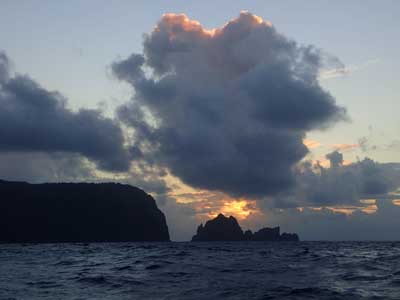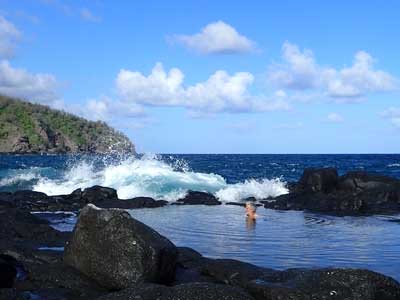Marquesas first impressions

It’s hot. It’s very hot. Even the locals think it’s hot. And humid. Everyone bangs on about these islands being Paradise, but I wonder, from a temperature point of view, if we didn't take a wrong turn somewhere.
People are friendly. Everyone says hello. We sat in the bank for a while yesterday and everybody was laughing and joking ... in Marquesan, of which we don’t understand one word yet, so we just grinned. Ah, there is just one word: ‘haka’ which means ‘dance’ and given the short demo this guy we met in the woods did, I can’t wait to see more. Better still, get Franco trained up, I think it would be just down his street. Everyone has a pick-up truck. The only fuel station is just on shore from where we are anchored, where the big boat docks, and at times, it is like Piccadilly Circus in the rush hour.
The anchorage Nearly everyone has tattoos. These are amazingly intricate and very beautiful. Before the missionaries arrived in the early 1800s, every inhabitant on the island was covered in tattoos from head to toe, and each one was unique. We’d been told: “There are fruit everywhere, you just pick it.” But we didn’t see any the first day as we stomped to the excellent pizzeria, just the other side of the point. How blind can you get! When we returned the same way yesterday morning to sign in with the ‘gendarmerie’ (the police part of the army that deals with border control) we were tripping over ripe mangoes. We sampled one and it was delicious. If you have read Roald Dahl (or be lucky enough, as I was, to have your mum read it to you), you will know that mangoes need to be eaten in the bath, and with good reason. So there we were, trying to look smart in our best clothes, with fingers, lips, faces, covered in sticky mango juice, on our way to sign into French Polynesia.
A store In Atuona
The war memorial - one person from this town died in each of the world wars Atuona, the small town, has much more than its size would suggest which isn’t surprising as it serves all the islands in the southern group. In addition to the regular stores, people drive in with goods for sale, we passed a truck selling tuna, unfortunately the chunks were too big for us. A couple of guys had set up stall and were selling pasties and other pastries as well as giant grapefruit for 100 Polynesian francs. At that point we were still blissfully mistaken about the exchange rate, we thought each grapefruit was worth 15p which seemed reasonable, bearing in mind that the locals don’t like them (too sour) and they grow everywhere. When we failed to extract money from the cash machine, we visited the bank and realised everything was (as we had been told) very expensive. Each grapefruit was in fact one dollar. “If one grapefruit is 100 francs, how much are two grapefruits?” I asked. “Two hundred francs.” “Could they be 150 francs?” I asked hopefully. “No. Two hundred francs.” I bought one. As the man put it in the bag, he added another. “One for free.” He said.
Grapefruits with a coconut and the mangoes On Sunday mornings, there is a market. Local people prepare cakes and savoury dishes that they trade before going to church, but you have to get up early as it starts at 4am. On the way back to the post office to buy a stamp (we needed to send our immigration document to Papeete, the capital in Tahiti), we passed the Gauguin museum. Much to my surprise, Franco is a fan, apparently he even had a picture on the wall of his bedroom as a student. Always open to new experiences, we headed in. All the paintings are cleverly executed copies, the originals are privately owned in galleries across the world and far too expensive to display in a tropical moist climate. I liked a couple but on the whole I fail to understand ‘Impressionism’. Gauguin, of course, only ever made pennies from his work, and I wonder how the four mothers of his eight children managed on their own.
Franco with one of his favourite Gauguin paintings Back at the dinghy park, you occasionally have to evict a child from your dinghy as the pontoon is where the kids come to play and swim. For many cruisers, Hiva Oa is the first port of call after many thousand miles of ocean passage and most don’t stay too long, with notable exceptions; Chris, a Brit, who’s been here three years, and a family on a big French boat who arrived a few days before us and plan to make Hiva Oa their home for the foreseeable future. The main meeting place seems to be at the laundry fountain where I have spent most of my time since we arrived. We accumulated an incredible amount of laundry because we went from cold, to not so cold, to warm, to very warm, to naked. Don’t believe Franco when he tells you I have been doing more chatting than washing, it simply isn’t true. This morning we set off earlyish (6:30) though earlier is always better, as by 7am, the heat is unbearable. We were going on a 10km walk to visit the ‘smiling tiki’. Our legs haven’t yet recovered from 40 days of inactivity so we hitched as we walked and eventually a woman with her two daughters took us as far as the path to the tiki. I commented that it seemed further than the 10km mentioned in the guidebook. The lady told us that the ten kilometres were from the drop off point, down a path! She dropped us off at a sign with a rough sketch. It seemed to suggest 10km to a turn off, then a further two to the tiki. We weren’t sure we would make it. Down the track a short distance, a sign said “turn right”. We did, and after a while arrived at a shack where pigs were wallowing in mud. We turned back and took the other path. The walking was pleasant, in the shade, under a mixture of forest and cultivated trees; papayas, bananas, mangoes and others we don’t yet recognise. We arrived at another small holding and the path disappeared. Heading off across country didn’t seem like a good idea so we turned back.
A forest tree As we were picking bananas, we spotted pale-skinned humans. Their guide Pifa, generously invited us to join them. We had missed the narrow path to the smiling tiki, just 10 minutes (not kilometres) down the track!
Smiling tiki This statue was carved sometime before 1800 yet it looks like it is wearing goggles. I can understand how Van Daniken could be mistaken in his book ‘Chariots of the Gods’. According to Pifa, the ‘goggles’ depict a visionary. On the way back we got a lift with the second vehicle that passed us. The driver had recently returned from France where he‘d been on a month-long technical course. He will be installing the high speed optic cable connection to Tahiti which will replace the current satellite arrangement. Fast broadband is coming to Paradise.
First sighting Friday morning
A rock pool where we go to cool down |
